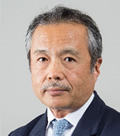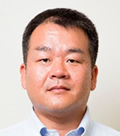EVENTイベント情報
We are pleased to announce that “The 4th International Symposium on AI and Electronics” is going to be held.

Program
| Session 1Session Chair Prof. Matsuura |
9:30-9:40 | Welcome addressPresident Hideo Ohno |
|---|---|---|
| 9:40-9:50 | Opening remarksProf. Toshiro Kaneko | |
| 9:50-9:55 | Announcement from Program chair | |
| 10:00-10:55 |
 Keynote speech 1
Keynote speech 1
Health and Science at GoogleDr. Joe Ledsam | |
| 11:00-11:30 |
 Invited talk 1 from a faculty member
Invited talk 1 from a faculty member
Creating Unique Ultrasonic/Photoacoustic Imaging for Medicine and BiologyProf. Yoshifumi Saijo | |
| 11:30-12:00 |
 Invited talk 2 from a faculty member
Invited talk 2 from a faculty member
Contactless Magnetic Gears and Magnetic-Geared MotorsProf. Kenji Nakamura | |
| 12:00-12:50 | Lunch break | |
| Session 2Session Chair Prof. Hirooka |
12:50-13:20 |
 Invited talk 3 from a faculty member
Invited talk 3 from a faculty member
Analog CMOS Implementation of Spiking Neural Networks for Edge ComputingProf. Shigeo Sato (online) |
| 13:25-15:00 |
On-demand sessionComments or questions to student presentations (selective) | |
| 15:00-15:10 | Break | |
| Session 3Session Chair Prof. Hamada |
15:10-16:05 |
 Keynote speech 2
Keynote speech 2
Signal Processing and Deep Learning Synergy: Speech Intelligibility in Noisy ConditionsProf. Yannis Stylianou (online) |
| 16:10-17:05 |
 Keynote speech 3
Keynote speech 3
Statistical Modeling: the three culturesProf. Adel Daoud (online) | |
| 17:10-17:20 | Closing remarksProf. Masahiro Yamaguchi | |
| 18:30-20:30 | Reception (Westin Hotel) |
 Keynote speech 1
Keynote speech 1
Health and Science at Google
Dr. Joe LedsamGoogle Japan
Abstract
Over the last decade, Google has played a leading role in the development and application of machine learning models. With particular reference to clinical medicine and computational biology, Dr. Joe Ledsam will provide an overview of some of Google's efforts to apply artificial intelligence to research challenges in science and healthcare. He will discuss approaches to the design of applied AI studies, and include clinical and technical learnings from Google and DeepMind's work in healthcare.
Biography
Dr. Joseph Ledsam is the Clinical Lead for Google Health in Japan where he works across AI research, digital health and health information in Google products. He has led multiple projects across medical imaging, genomics and EHR published in journals including Nature, Nature Medicine and Nature Methods. Before moving to Japan, he co-founded the Health Research and Genomics teams in Google DeepMind.
 Keynote speech 2
Keynote speech 2
Signal Processing and Deep Learning Synergy: Speech Intelligibility in Noisy Conditions
Prof. Yannis Stylianou (online)Professor at the University of Crete, Greece and Research Manger at Apple, UK
Abstract
There is long history on developing elegant signal processing algorithms for tackling key problems in everyday life. At the heart of these signal processing algorithms we can identify optimization, detection, estimation etc. in short explicit mathematical expressions. I refer to that as Explicit Representations. They have convolved inside them many years of theoretical developments and knowledge. They are Knowledge Driven.
However, quite recently a new way to address an increasing number of technological problems has been emerged: that of Deep Learning. An amalgam of linear and non-linear operators with the task to associate input and output data for classification as well as for generation. Deep Learning is based on data and results in an implicit modeling of data structure. I refer to that as Implicit Representations, or Data Driven.
Implicit Representations, are expensive in many ways, and actually questionable in their efficiency and robustness in key machine learning tasks. In this talk, I will speak about the synergy of these two representations for building efficient and effective systems/solutions. More specifically, I will present an example on how to build an end-to-end system for improving intelligibility of speech in noisy conditions, by combining Explicit and Implicit Representations (Knowledge and Data). This example may inspire you for more synergies of these representations in the future.
Biography
Yannis Stylianou is Professor of Speech Processing at University of Crete, in Greece and Research Manager at Apple, Cambridge UK. He was with AT&T Labs Research and Bell-Labs Lucent Technologies (1996-2002), Group Leader of the Speech Technology Group at Toshiba Cambridge Research Lab in Cambridge UK (2013-2018). He joined Apple in Aug 2018. He holds MSc and PhD from ENST-Paris on Signal Processing and he has studied Electrical Engineering at NTUA Athens Greece (1991).
He has (co-)authored more than 200 scientific publications in journals, conferences and chapters in books related to signal processing, and holds about 30 UK and US patents, which have received more than 8500 citations (excluding self-citations) with H-index=44. He was co-recipient of the 2018 ISCA Best Paper Award published in Speech Communication the period 2013-2017.
He was member of the IEEE Speech and Language Technical Committee (2007-2010, 2017-2019). He was on the Board of the International Speech Communication Association (ISCA) (2009-2013), of the IEEE Multimedia Communications Technical Committee, and on the Editorial Board of the Digital Signal Processing Journal of Elsevier and Associate Editor for the IEEE Signal Processing Letters.
He is an IEEE Fellow and an ISCA Fellow.
 Keynote speech 3
Keynote speech 3
Statistical Modeling: the three cultures
Prof. Adel Daoud (online)Associate Professor at Institute for Analytical Sociology, Linköping University, Sweden
Abstract
Social scientists distinguish between predictive and causal research. While this distinction clarifies the aims of two research traditions, this clarity is being blurred by the introduction of machine learning (ML) algorithms. Although ML excels in prediction, scholars are increasingly using ML not only for prediction but also for causation. While using ML for causation appears as a category mistake, this article shows that there is a third kind of research problem in which causal and predictive inference form an intricate synergy. This synergy arises from a specific type of statistical practice, guided by what we propose, the hybrid modeling culture (HMC). Navigating through a parallel debate in the statistical sciences, this article identifies key characteristics of HMC, thereby fueling the evolution of statistical cultures in the social sciences towards better practices—meaning increasingly reliable, valid, and replicable causal inference. A corollary of HMC is that the distinction between prediction and causation, taken to its limit, melts away.
Biography
Adel Daoud is an Associate Professor at Institute for Analytical Sociology, Linköping University, and Affiliated Associate Professor in Data Science and Artificial Intelligence for the Social Sciences, Department of Computer Science and Engineering, Chalmers University of Technology, Gothenburg, Sweden. Previously he held positions at Harvard University, University of Cambridge, Max Planck Institute for the Studies of Societies, and the Alan Turing Institute. His research has both a social-scientific and methodologically orientation. For the social sciences, he researches the effect of international development interventions (e.g., anti-poverty policies) on global poverty, but also the impact of sudden shocks (e.g., economic, political, and natural disasters). Daoud implements novel methodologies in machine learning and causal inference to analyze the causes and consequences of poverty. He has published in journals such as PNAS, Science Advances, World Development, International J of Epidemiology, and Ecological Economics, and machine-learning conferences such as Association for the Advancement of Artificial Intelligence (AAAI) and the North American Chapter of the Association for Computational Linguistics (NAACL). In 2022, Daoud was awarded the Hans L. Zetterberg Prize in Sociology which is given annually to young researchers, who with their scholarly work in sociology, preferably by fruitfully combining theory and practice, have advanced the research front. (More information is provided at www.adeldaoud.se)
Daoud leads The AI and Global Development Lab (more information at global-lab.ai). The vision of the Lab is to “combine AI, earth observation, and socio-economic theories to analyze sustainable and human development globally.” The Lab is mainly located at DSAI and IAS. The Swedish Research Council funds this Lab through a Research Environment Program and a Consolidator Grant. Pilot funding comes from Chalmers AI Research Centre (CHAIR). Google, in partnership with the Group on Earth Observations, provides mentorship and in-kind technical support for the Lab. Key partners of the Lab are Dept of Political Science, University of Gothenburg and the Department of Statistics, Harvard University.
Daoud is also the creator of a new podcast called the Journeys of Scholars. The Journeys of Scholars is a podcast with conversation about the trajectories, macro-micro strategies, habits, and advice of top-class academic performers. The conversation are about topics that are usually not discussed as systematically in public academic settings as they should be. While there is no one blueprint for academic success, these sessions are intended to provide advice and guidance for scholars striving toward excellence by observing how different top performers achieved their goals. After all, we all need the advice, assistance, and inspiration from our forerunners that paved the way for us toward new frontiers. The aim of this podcast is to supply these pieces of advice, assistance, and inspiration.
 Invited talk 1 from a faculty member
Invited talk 1 from a faculty member
Creating Unique Ultrasonic/Photoacoustic Imaging for Medicine and Biology
Prof. Yoshifumi SaijoProfessor, Graduate School of Biomedical Engineering, Tohoku University
Abstract
Ultrasound imaging is generally characterized as easy, non-invasive and inexpensive imaging modality. However, its most important merit is multi-scalability. Higher frequency ultrasound provides higher resolution image because the wavelength and beam width are inversely proportional to the frequency. We have been developing scanning acoustic microscope (SAM) for medicine and biology since 1980’s. SAM provides the information of biomechanical properties of tissues at the microscopic level because the square of sound speed is proportional to the elastic bulk modulus. SAM pioneered a unique field of biomechanical histology in the conventional histology based on the observation of chemical property by optical microscopy. Entering the 21st century, the target of SAM is changed from tissues to cells and much higher resolution is desired. However, sub-micron resolution ultrasound imaging was not available because the highest frequency used in SAM was limited to 1.3 GHz. Then we introduced photoacoustic imaging in which irradiation of nanosecond laser pulse induced rapid temperature rise and adiabatic expansion to generate photoacoustic (ultrasound) signal. Several unique photoacoustic imaging devices have been developed using key components made in Japan. One of them is sub-micron photoacoustic microscope with the resolution around 600 nm for cell.
Biography
Yoshifumi Saijo received the MD and the PhD degrees in 1988 and 1993 from Tohoku University. He had been trained as a cardiologist at Sendai Kosei Hospital and Tohoku Welfare Pension Hospital (currently Tohoku Medical and Pharmaceutical University Hospital) and he became a chief cardiologist to perform percutaneous coronary intervention at Fukaya Public Hospital in 1995. He returned to the Institute of Development, Aging and Cancer (IDAC) at Tohoku University for conducting research and development in medical ultrasound in 1997. He became a guest professor at Aarhus University, Denmark in 1999 and became an associate professor of IDAC at Tohoku University in 2004. He has been a professor of the Graduate School of Biomedical Engineering and the Graduate School of Medicine at Tohoku University since 2008. He is concurrent with a supervisor of the Clinical Technology Department at Tohoku University Hospital. He serves as the dean of the Graduate School of Biomedical Engineering at Tohoku University from April 2022.
His main research interests include high frequency biomedical ultrasound imaging, cardiovascular blood flow analysis and photoacoustic imaging. He was awarded in 1997 for his outstanding research paper in Ultrasound in Medicine and Biology, the official journal of the World Federation of Ultrasound in Medicine and Biology. His group received Best Paper Award from Symposium on Ultrasonic Electronics in 2017, 2019 and 2021.
 Invited talk 2 from a faculty member
Invited talk 2 from a faculty member
Contactless Magnetic Gears and Magnetic-Geared Motors
Prof. Kenji NakamuraProfessor, Graduate School of Engineering, Tohoku University
Abstract
Mechanical gears have a combination of two or more gears with different numbers of teeth, which can achieve various types of convert and transmit powers such as acceleration or deceleration, forward or reverse rotation, and power distribution. Thus, mechanical gears are used in various fields as one of the most important mechanical elements for transmission. However, because of mechanical contact, they have several drawbacks, including vibration, acoustic noise, and wear and tear. Furthermore, in the case of large-capacity machines, a lubricating oil system is required to cool the contact area and reduce wear and tear, which results in a more complicated system and frequent maintenance. To resolve the above problems, contactless magnetic gears have attracted attention. They have low acoustic noise and vibration, high maintainability, and no lubricating oil system due to no mechanical contact. Among them, a flux-modulated-type magnetic gear, which can achieve comparable or greater torque and efficiency than conventional mechanical gears, is expected for practical use. Furthermore, a magnetic-geared motor, in which a permanent magnet motor and a magnetic gear are magnetically integrated, has been attracting attention recently since it can reduce the overall size and weight in comparison with conventional mechanical-geared motors. Thus, it is expected to be applied for low-speed and high-torque applications, e.g., electric vehicle traction, marine propulsion, and wind power generation. In this presentation, several cutting-edge research on magnetic gears and magnetic-geared motors will be introduced.
Biography
Dr. Kenji Nakamura is a full Professor at the Graduate School of Engineering, Tohoku University. He received his B.E. and M.E. degrees from Tohoku University in 1998 and 2000, respectively. Since 2000, he has been with the Graduate School of Engineering, Tohoku University. In 2007, he received a Ph.D. degree in electrical engineering from Tohoku University. His current research interests include electric power apparatus and rotating machinery, and their application system such as electric vehicles, wind power generation, etc. Prof. Nakamura is a member of IEEE, the Institute of Electrical Engineers of Japan (IEEJ), the Magnetic Society of Japan (MSJ), and the Japan Society of Applied Electromagnetics and Mechanics (JSAEM). He received several awards, including the Paper Award from MSJ in 2008, 2021, and 2022, the Young Researcher Award from the Asian Union of Magnetics Societies (AUMS) in 2014, General Education Award from Tohoku University in 2014, respectively. He has served on the Technical Committee and the Administrative Committee of IEEE Magnetics Society. He is now working on a ProCom co-chair of the International Magnetics Conference (INTERMAG) held in Sendai, May 2023.
 Invited talk 3 from a faculty member
Invited talk 3 from a faculty member
Analog CMOS Implementation of Spiking Neural Networks for Edge Computing
Prof. Shigeo Sato (online)Professor, Research Institute of Electrical Communication, Tohoku University
Abstract
Low-power neuromorphic hardware is indispensable for edge computing. To reduce the power consumption to the limit, we employ a spiking neuron circuit with a 0.5 V voltage supply, in which all MOS transistors operate in the subthreshold region. We confirmed that the circuit successfully operated at less than 10 nW and reproduced various spikes similarly to the Izhikevich neuron model.
The most promising application of such a low-power neuron circuit is reservoir computing. Spatiotemporal signals can be classified utilizing high dimensional mapping function realized on a recurrent neural network. We implemented reservoir computing with a CMOS spiking neural network composed of 48 neurons, and found that highly efficient computing has been achieved in classification task of spoken words. I will report these findings and discuss the advantages of low power CMOS spiking neurons in its application to reservoir computing.
This study was supported in part by the Cooperative Research Project Program of the Research Institute of Electrical Communication, Tohoku University; JSPS KAKENHI (20H00596, 21H05164, 21K17818, 22H03657, 22K19821, 22KK0177); and JST CREST (JPMJCR19K3).
Biography
Shigeo Sato is currently a professor at Research Institute of Electrical Communication, Tohoku University. He received the B.S., M.S., and Ph.D. degrees from Tohoku University, Sendai, Japan, in 1989, 1991, and 1994, respectively. In 1996, he joined the Research Institute of Electrical Communication, Tohoku University. He received several awards including the Best Paper Award from IEICE in 1999, the Excellent Research Award from JNNS in 2019, and the Outstanding Paper Award from JSAP in 2019. His research interests are in LSI implementation and application of neural networks.





